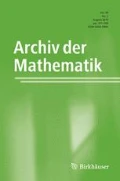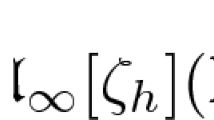Abstract
As shown by S. Lord, F. Sukochev, and D. Zanin (see [7]), the theory of singular traces is well understood for operators on the Hilbert space. The situation turns out to be completely different in the Banach space setting. Indeed, quite strange phenomena may occur. We will construct quasi-Banach operator ideals \({\mathfrak A}\) with seemingly contradictory properties: On the one hand, \({\mathfrak A}\) supports a continuous trace τ that vanishes at all finite rank operators, which means that τ is singular. On the other hand, \({\mathfrak A}\) contains the identity map I Z of an infinite-dimensional Banach space Z and τ (I Z ) = 1. This implies that there exist operators \({T \in \mathfrak A (Z)}\) such that \({\tau (T^n) = 1}\) for \({n = 1,2,{\dots} \;}\) , which is impossible for singular traces in the case of a Hilbert space. As most counterexamples, the new operator ideals have no useful application. They provide, however, a deeper insight into the philosophy of traces.
Similar content being viewed by others
References
Argyros S. et al.: Embedding uniformly convex spaces into spaces with very few operators. J. Funct. Anal. 262, 825–849 (2012)
Argyros S., Haydon R.: A hereditarily indecomposable \({\mathcal L_\infty}\) -space that solves the scalar-plus-compact problem. Acta Math. 206, 1–54 (2011)
Dunford N., Schwartz J.T.: Linear Operators, Vol I. Interscience Publ., New York. (1958)
Gowers T.W., Maurey B.: unconditional basic sequence problem. J. Amer. Math. Soc. 6, 851–874 (1993)
A. Grothendieck, Produits tensoriels topologiques et espaces nucléaires, Memoirs Amer. Math. Soc. 16, Providence, 1955 (Thesis, Nancy 1953).
J. Lindenstrauss and L. Tzafriri, Classical Banach Spaces, Vol. I, Springer, Berlin–Heidelberg–New York 1977.
S. Lord, F. Sukochev, and D. Zanin, Singular Traces, De Gruyter, Berlin, 2012.
A. Pietsch, Operator Ideals, Deutsch. Verlag Wiss., Berlin, 1978; North–Holland, Amsterdam–London–New York–Tokyo, 1980.
A. Pietsch, Eigenvalues and s-Numbers, Geest, &, Portig, Leipzig, and Cambridge Univ. Press, 1987.
Pietsch A.: History of Banach Spaces and Linear Operators. Birkhäuser, Boston (2007)
Pietsch A.: Traces and shift invariant functionals. Math. Nachr. 145, 7–43 (1990)
Author information
Authors and Affiliations
Corresponding author
Rights and permissions
About this article
Cite this article
Pietsch, A. Quasi-Banach operator ideals with a very strange trace. Arch. Math. 101, 243–252 (2013). https://doi.org/10.1007/s00013-013-0560-x
Received:
Published:
Issue Date:
DOI: https://doi.org/10.1007/s00013-013-0560-x




